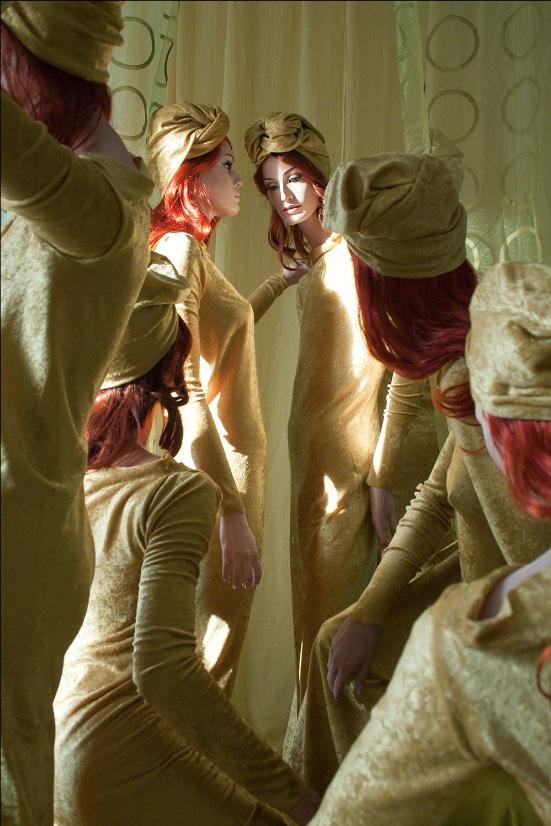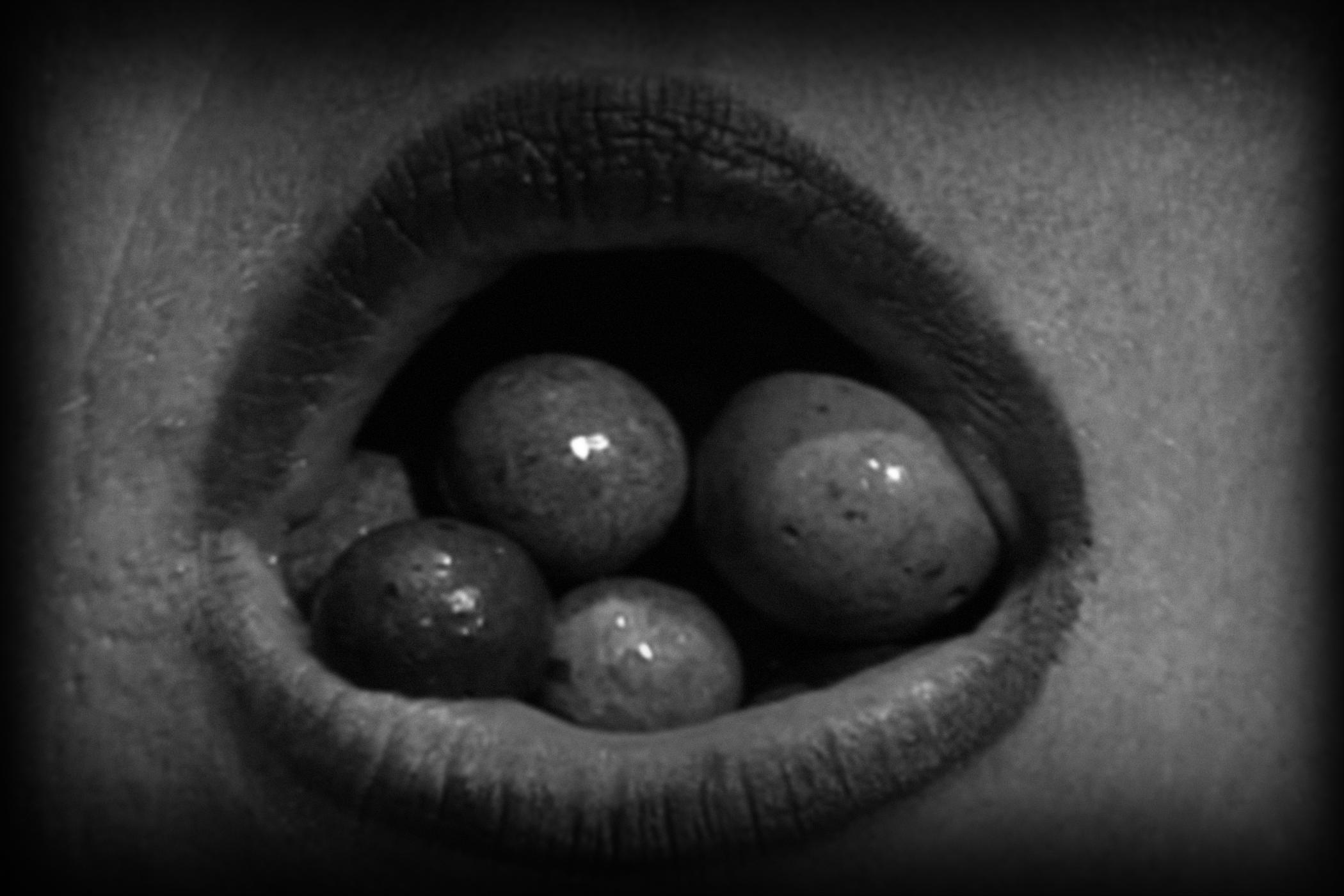
8 minute read
Brittany Cassell
Martine Gutierrez
By Birdie Piccininni
Advertisement
Martine Gutierrez, a Brooklyn-based artist, exhibits an impressive command over an array of artistic disciplines—photography, performance, video, fashion, sound, and installation art. Her work expresses transformations of herself into an assortment of idealized feminine roles of aspirational beauty and mannerisms while dealing with the composition of physical spaces and preconceived notions of identity. Gutierrez explores identity’s stern perpetuated perceptions by society when challenging differences between supposed opposites—male vs female, gay vs straight, and minority vs white. Gutierrez’s series, Line Ups (2014), uses her own body, mannequins, and lusciously designed backgrounds to investigate identity, not only as a collective, but also as a trans-woman in today’s society. The six mannequins are dressed identically to Gutierrez to evoke confrontations of stereotypical feminine roles.
The series contains seven highly stylized images depicting constructed, female gender representations with the use of gesture via mannequins and her own body. Her images do not only serve as a documentation of her inquiries but also as a performance in which the examinations occur. Her performance images place her in roles amongst society’s beauty and gender constructs that normally she would not be categorized under. Gutierrez’s discussion of gender roles alongside recent political discourse about transgender-preferred restroom usage offers an example of how toxic gender identity can be. Based in self-investigation, during the documentation of her explorations and journey, she realized her body was political. Though there was no political intent during the art’s conception the adjacency of the questions at play in her work, yet another layer is added to the photograph’s power. Gutierrez connects her inquiries on personal and collective identity throughout all of her projects. Her series Line Ups (2014) exhibits a significant doubt into what determines an identity and its imposed boundaries. The bold colors and uniformed scenes of the five mannequins used in each of the seven Line Ups (2014) photographs are a beautiful way to invite viewers to reflect on stereotypical feminine characteristics such as style and sexuality. Her work does not intend to be political but, in challenging societal norms which creates a resistance to what is believed and decided by the masses, it can be perceived as political.
BP: Who are you and what do you do?
MG: Martine Gutierrez, new media artist. I think of my works as documentation of performance. I don’t often do live performances, so people interact with the record via video or photography.
BP: What’s your background?
MG: The background on my computer is a picture from the Rootstein archives of John Taylor with the model Twiggy, taken in 1966 while producing a series of mannequins made to resemble Twiggy. Or perhaps, my educational background? I graduated from RISD with a BFA in fine arts. My major was printmaking, though most of my projects were sound driven video installations and public performances.
Or, are you asking ‘where are you from’? My mother is American and identifies as white, and my father immigrated here from Guatemala. They met in Berkeley, California, which is also where I was born and grew up.
BP: How do you work?
MG: I work simultaneously in different media. I sing, produce music, choreograph dance, construct costumes, style wigs and hair, do makeup, film, edit film, paint. I have enabled myself to adequately execute every aspect of a project so I may have full control in actualizing my ideas. If I were a movie star, I would also be the director, the scriptwriter, the composer and the movie production team. Needless to say I have learned how to compensate for no budget, without disrupting the surface of my glam veneer.
BP: What themes do you pursue?
MG: Perception, such as fluid perceptions of reality, ethnicity, and gender as they exist beyond binaries. I often question societies construction of dichotomies like ‘male’ vs ‘female’, ‘gay’ vs ‘straight’, ‘minority’ vs ‘white,’ and so on.
I am interested in every facet of what it means to be ‘genuine’, especially when performing in a role society would never cast me in. I stage the scene and emote, but the viewer sees what they want to see; they can actively engage with the work or passively make assumptions. While gender is inherently a theme in my work, I don’t see it as a boundary. The only profound boundaries are those we impose upon ourselves.
BP: How did it all start? Why did you create Line Ups?
MG: I began collecting mannequins because I thought they were alluring and a part of me wanted to identify with them. Although they are assigned female, their nude and wig-less bodies are extremely androgynous. In 2013 I started arranging myself into groupings with mannequins out of a desperation to belong to a community I could identify with. Throughout high school and college I identified as ‘gender fluid’ – and my sexuality was likewise undiscovered and open. I was afraid to lose the freedom of being everything, but isolated by the same truth, that I was nothing. Without a personal definition and pronoun, something to contextualize my person to a stranger, I was utterly ambiguous in every way. I longed for role models, companions, icons, and when I couldn’t find them, I made them. I didn’t know it at the time, but maneuvering all of my fem mannequin bodies, changing their physicality in every picture, as well as changing mine, was therapeutic in leading me to a greater understanding of myself and readiness to identify as trans female in the world.
BP: During our first studio visit you explained that your work wasn’t necessarily political but your body was, how did that affect your work?
MG: I don’t want it to affect my work. I don’t want the ugliness of the world to infringe on the escape my practice has always allowed me. To insure the safety of my artistic sanctuary, I protect the ideals of my childhood, my sister goddesses, by any means necessary. Like a cherished temple in the middle of a battlefield - one must protect what is sacred. We don’t live in a culture were people wish to be born trans women of color, but it has encouraged me to pursue the great destiny of my life.
There are no opportune moments for marginalized folks, you can’t wait in line to be heard, you must make your own opportunities, you must make them listen. Even if I don’t know where that will take me, and fear how people will treat me, at least I have direction and a temple of sisters.
The empowerment of belonging to a community gives us a shared understanding to withstand the adversity of existing in the world. My gift is joining the goddesses. My sacrifice is the cis realm.
BP: How has this series affected your process, work, or life?
MG: It’s changed it - and I believe my practice as an artist will continue to inform the way I identify, as it helps me understand why others categorize me the way they do. I am continuously intrigued by how others see me because it is often incorrect.
Martine Gutierrez, Line Up 4, Archival inkjet print on Arches Baryta mounted on sintra, 2014.

Ann Hamilton, (aleph · video), 1992–93. Video, color, sound, 30:00 mins (loop). 3.5 × 4.5 in.
Ann Hamilton
By Lux Yuting Bai
Visceral anxieties mount as I watch Ann Hamilton’s mouth slowly roll the stones. Her lips distort in tension. Her tongue is completely buried amid the marbles. I do not see her face, but I fear for her life. What if she accidentally swallows? What if she slips or breaks her teeth? What if she suffocates herself? The stones bump against each other, creating a sound that reveals their rough surfaces. She cannot utter a word. Physical pain has no voice. She cannot stop, either. Her mouth keeps rolling the rocks in loops like Sisyphus rolling the boulder up the hill. The vulnerable female body in seemingly perpetual pain evokes a sense of pathos. However, the struggle reaches beyond the confrontation between body and matter. Aleph, the first character of the Hebrew alphabet, represents the beginning of speech. The letter originates from the shape of the human larynx as it generates sounds. Notably, it is also an unpronounceable letter constituent of God’s name in Exodus. In (aleph · video) (1992–93), Hamilton subverts the divine connotation by highlighting the corporeality of the gesture of speaking. Alluding to the legend of Demosthenes, the Athenian orator who relentlessly practiced talking with rocks in his mouth, the work demonstrates that to speak is a perilous, tantalizing, and masochistic impulse. While the video asserts the primal, compulsive desire to raise realities into words, an epistemological question is presented here. (aleph · video) was first shown as part of a large-scale installation at the List Visual Arts Center, MIT. The exhibition featured a library of twenty thousand books that supported a mass of androgynous bulbous “bodies.” Hamilton parallels body with texts as an alternative site of knowledge and memories, suggesting that the nature of language is as sensual as it is intellectual, as atavistic as it is constructed. In a way, knowledge is accumulated through repetitive bodily experiences. A discrepancy between making sounds and having a voice appears. Like the paradoxical letter aleph, which embodies the effort of speaking yet is silent per se, the mouth successfully generates sounds while no intelligible meaning is conveyed. In a metaphorical sense, the movement is the “map” that represents communication. The unheard message is the “territory” that is forever unknown.






